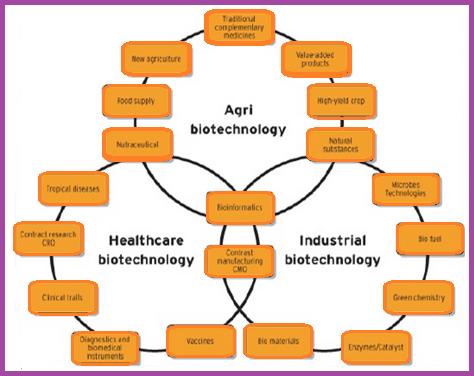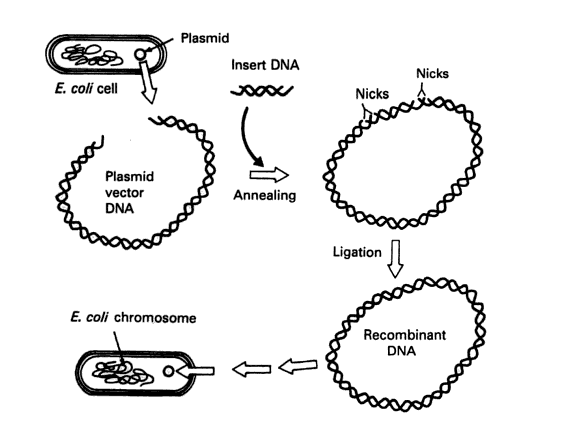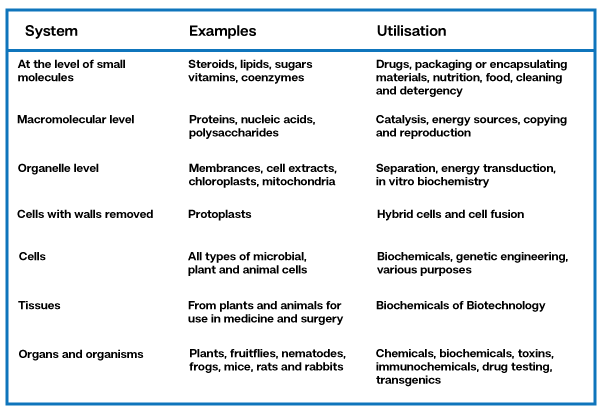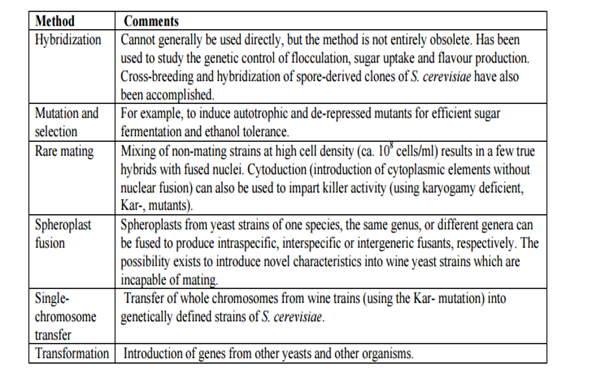Awareness in the fields of Bio-technology
Biotechnology is distinguished and developing sciences in modern scientific world. It elucidates the newest pattern of scientific advances which focus at deriving valuable products for human race through merging the biological systems with the engineering practices. The phrase 'biotechnology' was coined by the Hungarian engineer Karl Ereky in 1919 but this term has been used by humans since ancient times for producing food. In biological literature, Biotechnology is knowledge based on biology, particularly when used in agriculture, food science, and medicine. According to the UN Convention on Biological Diversity, Biotechnology means any technological application that uses biological systems, living organisms, or derivatives thereof, to make or modify products or processes for specific use. Biotechnology is normally described as the branch of biological sciences which involves the practice of livings organisms that is associated with plants, animals, birds, bacteria, fungi, viruses or other defined groups of living organisms and the biological procedures being done within these living organisms that include all the anabolic, catabolic and reproductive systems and processes in particular ways, using the modern engineering tools and procedures to develop valuable commercial goods at small and large scale. Other group of theorists explained the term biotechnology as application of principles of engineering and biological science to produce new products from raw materials of biological source such as vaccines or food. It can also be elucidate as the use of living organisms or their products to alter or improve human health and human environment. Biotechnology is extensively used in numerous disciplines at global scale. Numerous important scientific research institutions have initiated huge programs and projects in biotechnology and address number of problems for human race on earth for example food catastrophe through efficient utilization of biotechnological practices and approaches.
Development of Biotechnology
- Ancient biotechnology- Early history as related to food and shelter; Includes domestication.
- Classical biotechnology- Built on ancient biotechnology; Fermentation promoted food production, and medicine.
- Modern biotechnology- Manipulates genetic information in organism; Genetic engineering
Conventionally, biotechnology was defined as ancient ways of using living organisms to produce new products or adapt existing ones. Broadly speaking, traditional biotechnology can be drawn back to human's evolution from hunter-gatherer to agriculturalist. As ranchers, humans collected uninhabited plants and cultivated them and the best yielding strains were selected for growing the following seasons. From time to time, farmers discovered many plant varieties and they progressively became proficient at upbringing specific plant varieties to obtain desired qualities such as disease resistance, better taste and higher yield. In primordial time, humans unintentionally discovered the ways to use of natural processes that occur all the time within living cells. Though they did not have any scientific explanation for the processes, but they applied these techniques to get positive results such as food matures in a way that changes its taste and content, and makes it less consumable. When appraising modern biotechnology, it is denoted as several techniques that involve the planned manipulation of genes, cells and living tissue in an expectable and controlled manner to produce changes in the genetic make-up of an organism or produce new tissue. For example recombinant DNA techniques, tissue culture and mutagenesis. Modern biotechnology started with the 1953 discovery of the structure of deoxyribonucleic acid (DNA) and the way genetic information is transmitted from generation to generation. This innovation was made possible by the previous discovery of genes (discrete, independent units that transmit traits from parents to offspring) by Gregor Mendel. These discoveries laid the foundation for the changeover from conventional to contemporary biotechnology. Plethora of studies have demonstrated that modern biotechnology is often related with the use of genetically altered microorganisms such as E coli or yeast for the production of materials like insulin or antibiotics. It can also be denoted as transgenic animals or transgenic plants, such as Bt corn. Genetically modified mammalian cells, such as Chinese Hamster Ovary (CHO) cells which are also extensively used to manufacture pharmaceuticals. Other usage of new biotechnology is the development of plant-made pharmaceuticals.
Aspects of Biotechnology

Major goals of Biotechnology
- To understand more about the processes of inheritance and gene expression.
- To provide better understanding & treatment of various diseases, particularly genetic disorders.
- To generate economic benefits, including improved plants and animals for agriculture and efficient production of valuable biological molecules.
Major scientific disciplines where biotechnological processes frequently used are described below:
1. Genetic Engineering is perhaps the important arena among all sciences which biotechnological projects are used and deal with numerous problems. The use of technology to modify the genomes of viruses, bacteria, and other cells for medical or industrial purposes is called genetic engineering. Basically, genetic engineering encompasses the manipulation of genetic material of a living organism which may be plants, animals, birds, bacteria, fungi, viruses or other defined groups of living organisms in order to produce the anticipated changes in that living organism. In fact, the genetic material of any living organism controls all the activities and products of that organism, therefore by bringing the required change in the genetic material, biotechnologist can make that living organism work exactly in the desired way and produce exactly the desired product. It can be said that the use of genetic engineering becomes very important in biotechnology.
Insertion of foreign genes into bacterium (Source: Bryce, 2004)

2. Microorganism is also major source of biotechnology (Bryce, 2004). Biotechnologists are also interested in researching on microorganisms for their experiments and projects rather than dealing with macro organisms. Microorganisms include small microscopic organisms and macroscopic organisms involve large living organisms such as plants and animals. This is mostly because these microorganisms are easy to study and easy to work on as they have a relatively simple and understandable genetic makeup.
3. Embryology is also major branch of biology which involves biotechnological processes. Most of the biotechnological products depend upon the reproduction ability of the living organisms. As they reproduce, the scientists expect them to produce the desired product. The process of this reproduction is well understood by having good knowledge of embryology.
4. Other sciences like Physiology, Tissue culture, Histology, Molecular biology are also studied in biotechnology.
Table: Practicing biotechnology in various fields (Source: Bryce, 2004)

Applications of Biotechnology
Biotechnology has been applied in numerous industrial areas, that include health care (medical), crop production and agriculture, non-food (industrial) uses of crops and other products (biodegradable plastics, vegetable oil, biofuels), and environmental uses.
I. Applications of Biotechnology in Medicine: Major application of biotechnology is in the arena of medicine. Biotechnology is commonly linked with landmark advances in new medical therapies to treat diabetes, Hepatitis B, Hepatitis C, Cancers, Arthritis, Haemophilia, Bone Fractures, Multiple Sclerosis, Cardiovascular as well as molecular diagnostic devices that can be used to describe the patient population. Herceptin, is the first drug approved for use with a matching diagnostic test and is used to treat breast cancer in women whose cancer cells express the protein HER2. Contemporary applications of biotechnology is to explore new applications in the medicinal and health care fields. Some of the principal areas of application in the medicinal field include pharmacogenomics, drug production, genetic testing and genetic therapy. The use of biotechnology in the area of medicine is also called red biotechnology. It deals with major and minor aspects of human life, from a comparatively easy thing like making medicines more effective cost-wise and effect-wise to the one of most difficult branches of medicine curing genetic diseases. Red biotechnology also involve in discovering medicines for life threatening diseases like cancer, tumours and AIDS, improving the already existing procedures for various malignant diseases to decrease the side effects without compromising with the effectiveness, improving drugs and producing the various proteins used in human bodies artificially. Red biotechnology can be divided into biopharmaceuticals, gene therapy, pharmacogenomics and genetic testing.
Biotechnology assists in the development of treatments against disease in two ways: gene therapy and pharmacogenomics.
Gene therapy is that subdivision of red biotechnology that deals with the diagnosis and treatment of genetic diseases and some other diseases like cancer. In gene therapy, the treatment involves manipulating genes and correcting defecting genes. Genes are inserted, deleted or modified as the treatment requires. This can provide a permanent or semi-permanent cure. The most general type of gene therapy involves the insertion of functional genes into an unspecified genomic location in order to replace a mutated and dysfunctional gene. This technology is still new but has great prospective. Gene therapy can follow one of three approaches that include the replacement of a faulty gene with a normal gene; the inactivation or 'knocking out' of the faulty gene; or introducing a completely new gene into the body to fight the disease.
Genetic testing is contentious applications of biotechnology and includes two major types that include use of DNA probes with sequences similar to mutated sequences and the other method involves the scientist conducting the genetic test by comparing the patients DNA sequence against a healthy persons DNA sequence. Applications of biotechnology in genetic testing enable the researcher to determine sex, carrier screening, prenatal diagnostic screening, new-borns screening and even forensic and identity testing.
Pharmacogenomics is principally the study of genetics and pharmaceuticals. In this process, genetic inheritance of an individual has on the way their bodies respond to drugs and medications. Biotechnology offers new possibilities in the design and production of drugs and how they can be adapted to each individual and their genetic makeup. There are several benefits of biotechnology applications in pharmacogenomics such as development of custom medications, accurate methods of determining proper dosages of medications, improvements in the discovery of new drugs and getting those drugs approved, and better and safer vaccinations. Pharmacogenomics can play an important role in oncology, treatment of high blood cholesterol levels, tailoring treatment for people with psychiatric disorders, treatment for people with cardiovascular diseases.
Pharmacogenomics and genetic testing techniques are individual specific. Pharmacogenomics studies genetic information of the individual and develops drugs that can be inserted into that particular individual. Genetic testing tests the family tree to define the genetic diseases, sex and carrier screening.
Biotechnology offers another possibility through which therapies and treatments can be developed. Through the development and use of biotechnology practices, scientists determine the structure of DNA and also the coded message in the gene that is contained within the DNA. The sequence of genes on an organism's DNA is responsible for the individual traits of that organism.
Biotechnology is also used as a tool in diagnostics in order to monitor food safety, prevent and diagnose food-borne illnesses and verify the origins of foods. Methods applied in the assurance of food safety focus on the detection and monitoring of hazards whether biological, chemical or physical. Biotechnology plays a vital role in modern diagnostic science. Biotechnologists can examine a person's DNA usually taken from a blood sample to do the following:
- Determine the sex of an unborn baby
- Carrier screening
- Prenatal diagnostic screening such as screening for Down syndrome.
- Newborn screening: testing newborn babies for HIV, phenylketonuria (an inborn metabolic disorder, leading to abnormally high levels of the amino acid phenylalanine, which if left untreated can cause severe mental retardation)
- Presymptomatic testing for predicting an adult-onset disorders.
- Presymptomatic testing for estimating the risk of developing adult-onset cancers
- Confirmational diagnosis of symptomatic individuals: for example cystic fibrosis and Huntington's disease
- Forensic/identity testing: For example analysis of semen for prosecution of sexual offenders, analysis of blood, bone and hair of murder victims, paternity testing.
Applications of Biotechnology in Agriculture: Agricultural biotechnology is the area of biotechnology that involves uses of biotechnology to agriculture. Agricultural biotechnology has been practiced since ancient time as people have sought to improve agriculturally important organisms by selection and breeding. In the decade of 1970s, progression in the field of molecular biology enabled scientists to manipulate DNA the chemical building blocks that specify the characteristics of living organisms at the molecular level. This technology is known as genetic engineering. Currently, this technology has reached to a stage where scientists can take one or more specific genes from nearly any organism, including plants, animals, bacteria, or viruses, and introduce those genes into another organism. Existing genetic engineering techniques permit segments of DNA that code genes for a specific characteristic to be selected and individually recombined in the new organism. Although genetically engineered organisms in agriculture have been available for several years, their commercial use has extended rapidly. Recent estimates are that more than 60-70 percent of food products on store shelves may contain at least a small quantity of crops produced with these new techniques.
There are many advantages of genetic engineering to agricultural biotechnology in agriculture:
- Increased crop productivity: Biotechnology has made possible to increase crop productivity by introducing such qualities as disease resistance and increased drought tolerance to the crops. Currently, scientists can select genes for disease resistance from other species and transfer them to important crops.
- Improvements in food processing: Biotechnology considerably enhance the quality of food. The first food product resulting from genetic engineering technology to receive regulatory approval, in 1990, was chymosin, an enzyme produced by genetically engineered bacteria. It replaces calf rennet in cheese-making and is now used in 60 percent of all cheese manufactured. Its benefits include increased purity, a reliable supply, a 50 percent cost reduction, and high cheese yield efficiency.
- Improved nutritional value: Genetic engineering has permissible new options to improve the nutritional value, flavour, and texture of foods. Transgenic crops in development include soybeans with higher protein content, potatoes with more nutritionally available starch and an improved amino acid content, beans with more essential amino acids, and rice with the ability produce beta-carotene, a precursor of vitamin A, to help prevent blindness in people who have nutritionally insufficient diets.
- Better flavour: Through the application of biotechnology techniques, food can have good flavour. Flavour can be changed by enhancing the activity of plant enzymes that transform aroma precursors into flavouring compounds. Transgenic peppers and melons with improved flavour are currently in field trials.
- Fresher produce: Genetic engineering can result in improved keeping properties to make transport of fresh produce easier, giving consumers access to nutritionally valuable whole foods and preventing decay, damage, and loss of nutrients.
- Environmental benefits: When genetic engineering results in reduced pesticide dependence, there is less pesticide residues on foods, reduce pesticide leaching into groundwater, and minimize farm worker exposure to hazardous products.
Applications of Biotechnology in Food Processing: Biotechnology application to food processing in developing countries make use of microbial inoculants to enhance properties such as the taste, aroma, shelf-life, texture and nutritional value of foods. The process whereby micro-organisms and their enzymes bring about these desirable changes in food materials is called fermentation. Fermentation processing is extensively applied in the production of microbial cultures, enzymes, flavours, fragrances, food additives and a range of other high value-added products. These high value products are increasingly produced in more technologically advanced developing countries for use in their food and non-food processing applications. These highly nutritive products are also imported by developing countries for use in their food-processing applications. Technologies applied in the processing of food must assure the quality and safety of the final product.
Biotechnological processes applied to the improvement of microbial cultures for use in food processing applications include traditional methods of genetic improvement ("traditional biotechnology") such as classical mutagenesis and conjugation. These methods generally focus on improving the quality of micro-organisms and the yields of metabolites. Hybridization is also used for the improvement of yeasts involved in baking, brewing and in beverage production. Recombinant gene technology, the best-known modern biotechnology, is broadly used in research and development for strain improvement. The availability of genetic manipulation tools and the opportunities that exist to improve the microbial cultures related with food fermentations are tempered by concerns over regulatory issues and consumer perceptions. Genetically modified microbial cultures are used in the production of enzymes and various food-processing ingredients such as monosodium glutamate, polyunsaturated fatty acids and amino acids.
Table: methods employed in genetic research and the development of wine yeasts ( Source: Pretorius, 2000)

To summarize, biotechnology is the application of scientific methods to alter and improve plants, animals, and microorganisms to increase their value. Biotechnology is a vastly interdisciplinary field that combines biological sciences with engineering technologies to manipulate living organisms and biological systems to produce products that modernize healthcare, medicine, agriculture, food, pharmaceuticals and environment control. Biotechnology is skilful use of biological agents to benefit humans. It is combined use of biochemistry, molecular biology, microbiology to achieve technological application of the capabilities of biological agents. Consequently, biotechnology has developed as a science with huge potential for human wellbeing that range from food processing, human health to environment protection. Biotechnology has vital role in highly advanced and technically evolving period of human history and it gives promising results.

